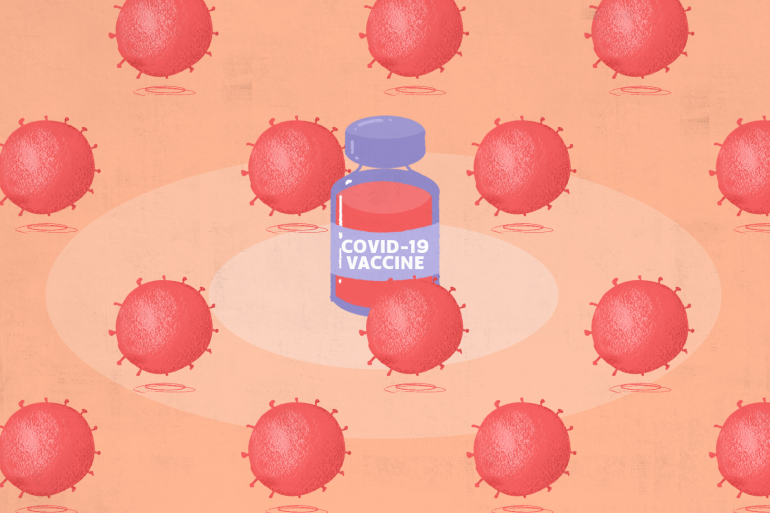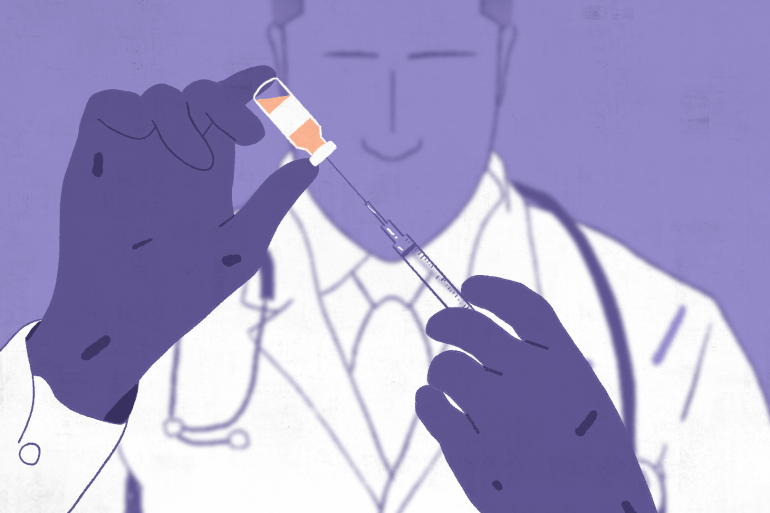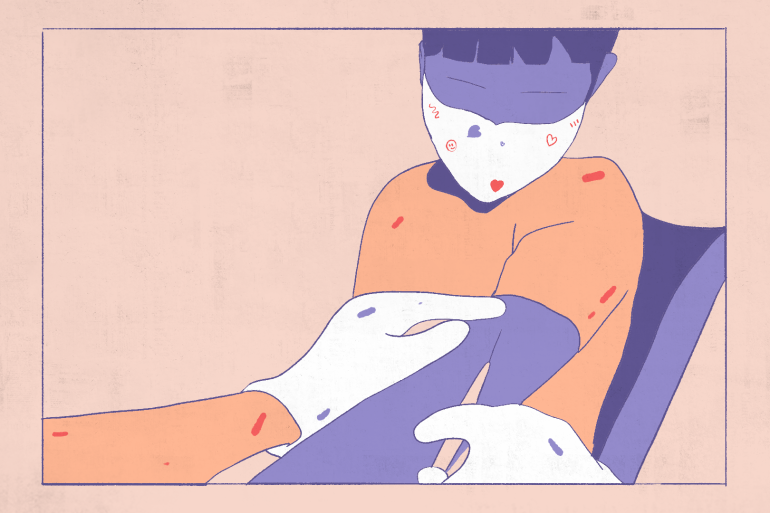Which offers the best protection: A COVID infection or vaccines?
Is it safer to risk the rare side effects of jabs than catching COVID without the protection that vaccines offer?

The question of whether antibodies produced as a result of natural infection from COVID-19 offer more or less protection than those acquired through vaccination has been asked many times since the vaccines were rolled out.
A new study from Israel, which is yet to be peer reviewed, concluded that natural immunity confers longer-lasting and stronger protection against infection, symptomatic disease and hospitalisation caused by the Delta variant of SARS-CoV-2, compared with immunity induced from two doses of the Pfizer-BioNTech two-dose vaccine.
Keep reading
list of 3 itemsHow worried should we be about COVID-19 breakthrough infections?
As new COVID variants emerge, is herd immunity impossible?
It went on to say those who had had a previous COVID-19 infection followed by vaccination were even better protected. Another study has shown that even those with mild infections from COVID-19 mount good enough immune responses to help reduce the risk of re-infection in the future.
The first thing to point out when discussing this is that several studies have shown that vaccines protect people against serious illness caused by COVID-19 and have prevented countless deaths from the disease. It is, therefore, safer to get the vaccines than it is to run the risk of contracting COVID without the protection that vaccines offer.
Both the short- and long-term health risks associated with a COVID infection are substantial as the illness can affect almost any organ in the body and many people now have severe disabilities as a result of a COVID infection.
Of course, there are some rare risks associated with the vaccines – rare blood clots connected with the AstraZeneca vaccine and the very rare risk of myocarditis (heart inflammation) in the case of the Pfizer vaccine are just two. But on balance, the benefits of having the vaccines outweigh any of these risks and my advice would be to have them.
To understand why this debate is taking place, it is important to understand the types of antibodies vaccines and natural infection trigger.
Natural antibody protection occurs after a person has been infected with the SARS-Cov-2 virus causing COVID. The initial response is by the innate immune system, which recognises the viral material as “foreign” and begins removing it while also signalling to other parts of the immune system to join the fight. This initial response from the innate immune system limits the viral spread to other cells in the body.
After this, T-cells – another part of the immune system – are recruited to identify infected cells and destroy them. T-cells recognise infected cells as they have identifying markers on their outer surfaces signalling that they are infected.
Memory B cells are also formed at this point, these mount a rapid immune response should the individual come into contact with the SARS-Cov-2 in the future. If the virus mutates then these B-cells may not be able to recognise it and may take longer to activate the rest of the immune system.
Generally speaking, people who have had more severe disease tend to have higher levels of antibodies, most likely due to higher viral loads and prolonged exposure to the virus.
The Pfizer and Moderna vaccines, which use mRNA technology, and the AstraZeneca vaccine, which uses a modified harmless version of a virus, have different modes of action but both work by stimulating the immune system to recognise the spike protein part of the SARS-Cov-2 virus as foreign. This is the part of the virus that allows it to bind to and enter human cells.

The vaccines induce the same T-cell response as natural infection as well as the production of B memory cells. But, whereas natural infection exposes the immune system to a wider range of viral material and several viral proteins, the vaccines give a more targeted response to parts of the spike protein only and in this regard are more restricted. However, vaccine-induced protection comes with a much lower risk of serious illness than that associated with natural infection, which is something the Israeli study does not address.
Many people who are vocal about not wanting to be vaccinated may look at the study from Israel and cite it as a justification, arguing that natural infection gives greater protection. But this is a flawed argument as, for many, COVID is not a mild disease. It has caused the deaths of millions of people around the world and many, including some of my patients, are living with the long-term consequences of the disease. Then there are those who present the risks associated with the vaccines as reason enough not to have them, but this, too, is flawed reasoning: there is a higher risk of developing myocarditis or blood clots from natural COVID infections than there is as a result of vaccination.
The pandemic is far from over, and as we have seen already this virus has a habit of throwing us curveballs. The focus needs to be on reducing transmission through social distancing measures and looking at ventilation in indoor settings, as well as encouraging everyone to take up the vaccines. Relying on natural infection to protect you is a gamble not worth taking, and as studies have shown getting the vaccines after having had COVID will protect you even more. All of these are reasons to take up the vaccine when offered.
Progress Report: COVID boosters
The use of a third dose of the COVID vaccines to help increase protection against the virus and boost the immune response remains a hotly debated topic. I was asked about boosters recently during a television interview, after leading UK scientist and co-developer of the AstraZeneca vaccine, Professor Dame Sarah Gilbert, said she didn’t think they were necessary for everyone and that protection from the vaccines were “lasting well”. I responded that there were two things to consider when looking at COVID boosters:
- Does the protection from the COVID vaccines wane over time?
- Will a third dose offer longer-lasting protection?
A large UK study has shown that although protection levels induced by vaccinations remain good they do wane after three months. Based on more than three million nose and throat swabs taken across Britain, the Oxford University study found that 90 days after a second shot of the Pfizer or AstraZeneca vaccine, their efficacy in preventing infections had slipped to 75 percent and 61 percent respectively. That was down from 85 percent and 68 percent, respectively, seen two weeks after a second dose. The decline in efficacy was more pronounced among those aged 35 and older.
Although this may sound alarming, it is important to note that vaccines do offer good protection against hospitalisation and severe disease even after six months. This is because they promote the production of memory cells that remember parts of the virus and mount an immune response should you come across it in the future. These are different from the neutralising antibodies which form part of the initial immune response and help protect even against mild disease. So it appears that, even though the neutralising antibody levels drop after three to six months, memory cells remain, meaning that people who have had both doses of the vaccines may be at risk of breakthrough infections and mild disease but remain protected against severe illness.
It is important to say at this stage that those who have compromised immune systems or are elderly are less likely to mount the same level of immune response and gain the full benefits from vaccines so they would almost certainly benefit from a third dose or booster shot.
For the rest of us, booster doses will certainly help increase our neutralising antibody levels and offer us better protection against mild to moderate disease but this has to be balanced out against the ethical arguments. Should people in richer developed nations be given a booster shot at the expense of sharing these doses with poorer developing nations that are yet to offer a first dose to some of their population?
On this my views are aligned with Professor Dame Sarah Gilbert: booster shots are needed for the immunocompromised, those with underlying health conditions, front-line healthcare workers and people aged over 65, but beyond that, any excess doses should be donated to poorer countries which will gain more benefit. This is not entirely selfless. Further mutations of the virus are likely to arise in countries where COVID cases are on the rise, increasing the chance of a mutation that results in better transmission or, even worse, evasion of vaccine-induced protection. By offering our excess vaccine doses, we will help get more people across the world vaccinated, reducing the risk of mutations developing.
Booster shots remain a controversial topic and more and more developed nations, including the US and the UK, are pressing on with mass-scale booster programmes. But it is always worth remembering that this is a global pandemic and as the saying goes: no one is safe until everyone is safe.

Good News: Cuba works on vaccine programme to open schools
The pandemic has undoubtedly adversely affected the education of children. Schools across the world closed as cases peaked to help reduce the spread of the virus and lessons moved online. There is no substitute for classroom teaching and although teachers have been working exceptionally hard, the educational impacts from this pandemic will remain with us for many years.
In Cuba, many schools have been closed since March 2020 and they are set to reopen for classroom teaching in October. On the back of rising infections across the island, the government has authorised the use of its domestically produced Abdala and Soberana vaccines for those aged 12 and above and, following this, for younger children.
The Cuban vaccines have not been approved by the World Health Organization (WHO) but health authorities in Cuba claim the vaccines have above 91 percent efficacy against SARS-Cov-2. Cuba, which has a long history of producing its own vaccines, has an advanced biotechnology centre and even exports some to neighbouring countries. Its COVID vaccines use the spike protein part of the coronavirus which is injected alongside an adjuvant that helps it enter cells, which then recognise the spike protein as foreign and mount an immune response.
If the vaccines are as effective as the Cuban trials suggest, then they may well allow schools to open safely and education to return to normal.
In the Doctor’s Surgery: An influx of non-COVID cases
The summer period in primary care is usually less busy than the rest of the year. We tend to use this time to focus on our patients with more chronic illnesses and ongoing symptoms. But this summer has been unlike any I have seen in my 17 years as a clinician. We are seeing unprecedented levels of both mental and physical illnesses and the surgery has never been busier.
The combination of the previous lockdown that saw patients not coming into the surgery for fear of contracting COVID or worrying about being a burden, combined with a rise in common infections that have resulted from a sudden ability to mix with others, has meant that I often finish work hours after I am supposed to.
I don’t mind seeing extra patients, that is all part of my job as a primary care clinician. The problem is that along with demand there seems to be an increased level of abuse directed towards primary carers.
In order for us to remain open and operate safely during the pandemic, we had to change the way we worked. We could no longer allow large numbers of people to be in the waiting room nor could we see everyone who wanted to be seen for minor ailments. We operated a triage system, performing remote consultations for those for whom that was safe, while bringing those we felt needed to be seen in person into the surgery. At the same time, we continued with childhood immunisations, cervical screening and other essential clinical programmes. We also continued our antenatal services, seeing pregnant women for their routine check-ups. Primary care has also been responsible for much of the COVID vaccination programme across the UK and I often do shifts in our vaccination centre based at the surgery.
The problem we have now is that against the backdrop of this increased demand, we are approximately 5,000 GPs short across the UK – something that is a result of a decade of underfunding and poor workforce planning by the current government. Many GP surgeries are unable to recruit new doctors and the workload for existing GPs is becoming unmanageable, forcing some to switch to part-time working hours in a desperate attempt to gain some work-life balance.
All of this is bad for GPs but also for patients who then struggle to get an appointment. Some right-wing UK newspapers have accused GPs of being lazy and not seeing enough patients, but the reality is there simply are not enough doctors to see everyone who wants to be seen. Instead, we aim to see everyone who needs to be seen, which means a level of triage is required to direct those who do not need to see a doctor to more appropriate services. This has led to a breakdown in what was a very good relationship between the general public and primary care and increased levels of abuse from frustrated patients and news outlets with sinister agendas, as well as poor morale among my colleagues.
It will take years to build up the workforce we need in primary care as well as appropriate funding. In the meantime, GPs will continue to work hard for their patients and will try to counter the false claims made by many of our national newspapers about the way we work.
Reader’s Question: Are you more likely to get myocarditis from COVID vaccines or COVID itself?
Myocarditis refers to inflammation of parts of the heart muscle. In otherwise healthy people it presents with chest pain and palpitations and most people recover well with the help of medication.
It has been listed as an extremely rare side effect of the mRNA vaccines Pfizer and Moderna. In the latest study from the University of California, the rate of myocarditis after two shots of Pfizer-BioNTech vaccine is estimated to be 162.2 cases per million for healthy boys aged 12 to 15 and 94 cases per million for healthy boys aged 16 to 17. The equivalent rates for girls were 13.4 and 13 cases per million, respectively.
It is worth noting this study has been criticised by scientists and medics for overestimating the rates of myocarditis in young people by using differing parameters for diagnosis than what is accepted by some. It is likely the rates are much lower.
Clearly, young males are more at risk of developing myocarditis after the vaccine, but studies show they are six times more likely – 450 per million – to get it from an acute COVID infection than from a vaccine.
It is sometimes difficult to know what to do as a parent when your child is offered the COVID vaccine, particularly with all the misinformation circulating online, but the data shows young people stand to benefit more from getting the vaccine than risking an infection.